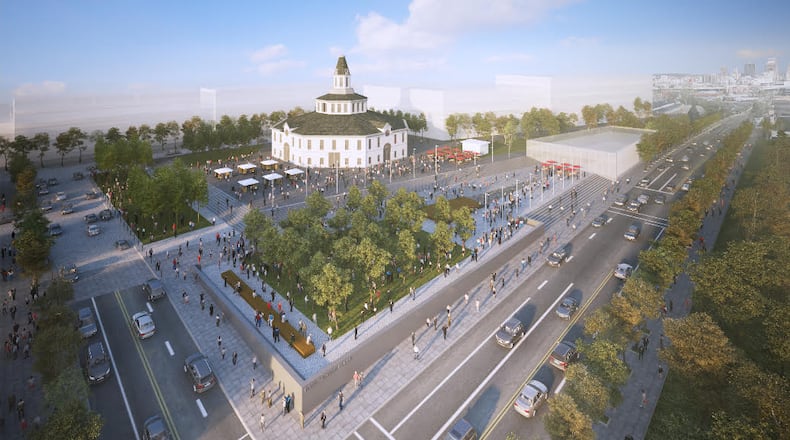Those shepherding the onMain project always expected to see substantial state, and perhaps, federal, sums involved. But Monday’s announcement came with the most specific proposal yet for what they hope will be built there.
What was Monday’s announcement?
The building will be focused on assisting the Air Force with its ongoing digital transformation work — digital management of materials and equipment. Those advocating for the work say half-a-billion dollars in new research dollars could be pulled to the hub by 2031.
“The new OnMain Innovation Hub will bring together the region’s best academic institutions, industry leaders, government partners and our nation’s military to drive advancements in national defense and aviation — two industries that Dayton knows so very, very well,” Gov. Mike DeWine said Monday at a University of Dayton gathering.
Thinkers and doers from Wright-Patterson Air Force Base — “also known as the greatest military installation in the world,” in the words of Eric Spina, president of the University of Dayton (UD) — will be integral to what happens at the building.
“A centralized hub for innovation, collaboration, training, fostering existing partnerships and building new ones and the ability to do it in classified spaces,” is how Robert Fookes, chief engineer for Air Force Materiel Command at Wright-Patterson, described how the new building can be put to use. “I said this before, and I truly believe Dayton is the epicenter for digital transformation for the Air Force.”
“Dayton is hot,” the governor said. “Dayton is moving, the Miami Valley is moving forward. Today is just another great example of that.”
How did we get here?
The saga started in about 2016 — and before then, really — with a search by those responsible for the Montgomery County Fairgrounds for a new home.
The new locale was expansive, already fitted with water and sewer connections. And it was far larger than the 38-acre downtown South Main Street property left behind.
But quickly, the question arose: What to do with the soon-to-be-empty Dayton site?
UD, Premier form OnMain Inc.
In early 2019, UD and Premier Health — the two entities located closest to the former fairgrounds — created a nonprofit corporation to guide redevelopment.
The university and health care provider announced the previous fall that they would rename the site “onMain: Dayton’s Imagination District.”
Their vision was a bit murky at first. UD and Premier jointly purchased the fairgrounds in 2017. The fairgrounds’ iconic “roundhouse” was identified as a potential landmark or gathering space. A web site — onmaindayton.com — was built.
Full redevelopment was expected to take a decade or longer.
OnMain — and the need for funding — start to take shape.
Buddy LaChance, then chief executive of onMain Inc., said in 2019 that the project needed funds from the state, possibly from JobsOhio and from the U.S. Army Corps of Engineers and the U.S. Economic Development Administration, among other potential backers.
“Because we’ve got so much infrastructure that we need to build, we are certainly looking every place we can,” LaChance said in 2019.
The vision for the site evolved, at various points including a buildout of more than a dozen residential and business buildings, along with a park, trails and plaza. A funding application suggested the project could create more than 1,000 jobs.
Brian Heitkamp, OnMain’s CEO today, said UD and Premier Health will remain the largest local investors, with conversations beginning with other potential local partners.
Pandemic, delays and redirection
The COVID-19 pandemic intervened when the new virus was first felt domestically in the spring of 2020.
But work continued. By last year, Dayton leaders considered declaring the former fairgrounds a blighted area, which they thought could help attract tax abatements.
Then, earlier this year, UD and Premier Health nailed down a property tax abatement agreement with Dayton Public Schools.
Next steps
DeWine Monday said he expects about $35 million to come from the state and about $60 million from local public and private investors.
The governor called the Dayton region a place where “big ideas take flight.”
“It’s very gratifying,” DeWine said after his public remarks. “This idea (Ohio innovation hubs) started about two years ago, specifically to set this money aside, not for big cities but for what we call mid-sized cities. We’ve already announced Toledo; today we announce Dayton.”
“There’s a lot going on in these communities,” he added. “And I think many times our mid-sized cities think they’re forgotten by the state. And that’s just not true.”
About the Author




